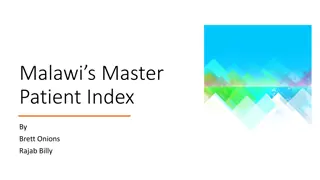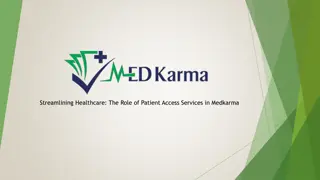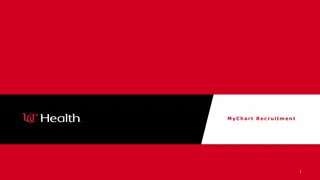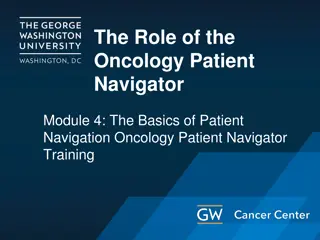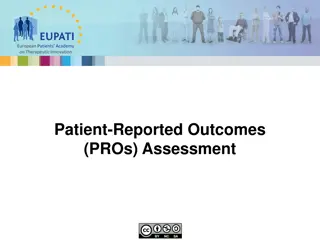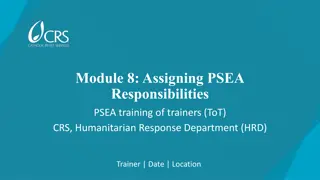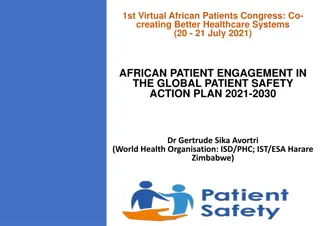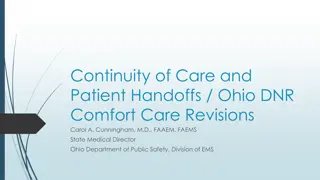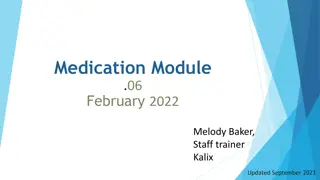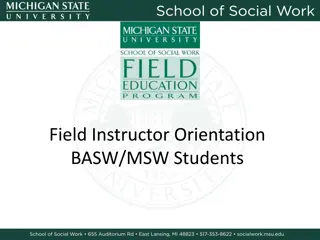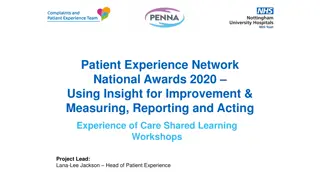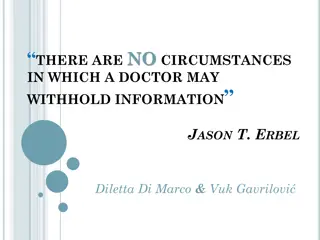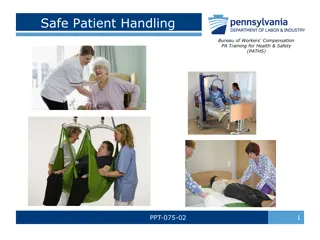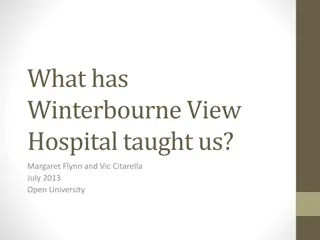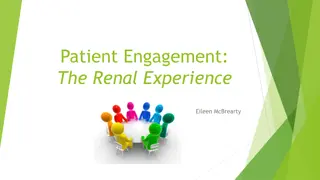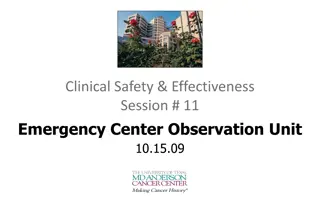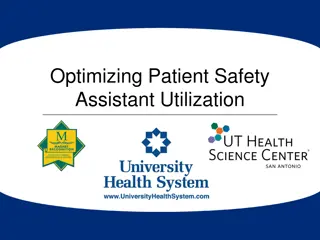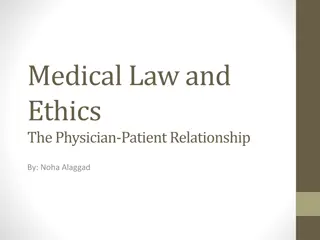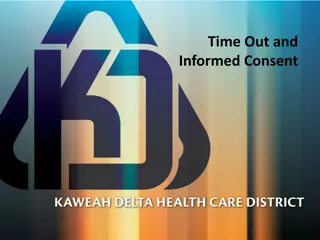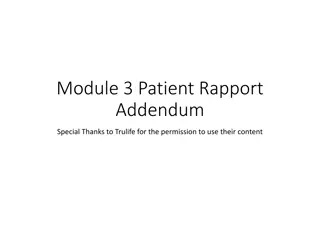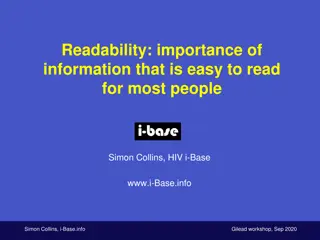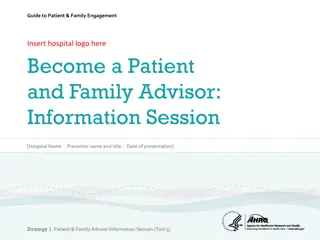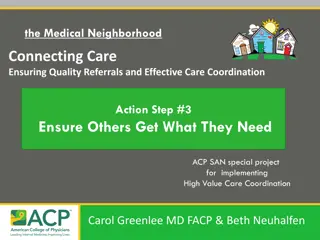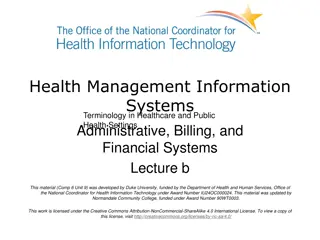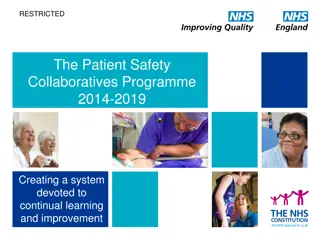Modernize Patient Experience with Digital Patient Conversion Platform
Enhance patient relationships and streamline your practice with a secure digital patient conversion platform. Acquire new patients online, modernize patient experience, retain existing patients, and optimize technology investments. Utilize tools like online booking, digital check-in, and workflow au
0 views • 31 slides
Understanding the Patient Safety Incident Response Framework (PSIRF)
The Patient Safety Incident Response Framework (PSIRF) is set to replace the Serious Incident Framework (2015) within the NHS, marking a significant shift in responding to patient safety incidents. Its key aims include compassionate engagement, system-based learning, proportionate responses, and sup
5 views • 9 slides
World Patient Safety Day 2023: Engaging Patients for Patient Safety
World Patient Safety Day 2023 emphasizes engaging, raising, advocating, and empowering patients for safety in healthcare. Major activities include taking the pledge of "First Do No Harm," promoting patient safety at Health Mela events, recognizing safety champions, and sharing innovative learnings.
6 views • 15 slides
Enhancing Healthcare Services in Malawi through the Master Patient Index (MPI)
The Master Patient Index (MPI) plays a crucial role in Malawi's healthcare system by providing a national patient identification system to improve healthcare quality and treatment accuracy. Leveraging the MPI aims to dispense unique patient IDs, connect with existing registries, enhance data managem
4 views • 8 slides
Rwanda HIE Patient Identity Management System Overview
The Rwanda Health Information Exchange (HIE) system focuses on patient identity management to uniquely identify individuals seeking healthcare across the country. By maintaining a set of identifiers in the client registry and avoiding duplication of patient records, the system ensures efficient and
12 views • 8 slides
Streamlining Healthcare, The Role of Patient Access Services in Medkarma
In the labyrinth of healthcare, where patient needs intersect with administrative procedures, lies a critical component often overlooked \u2013 Patient Access Services. In the realm of Medkarma, this integral function serves as the linchpin, orchestrating seamless transitions from patient inquiries
3 views • 8 slides
Efficient Patient Recruitment and Messaging in MyChart
Streamline your patient recruitment process in MyChart by accessing, finding eligible patients, sending messages, and tracking responses effectively. Learn how to access reports, find and select patients, send recruitment requests, send patient-facing messages, and track patient responses for resear
0 views • 7 slides
How to Add a Patient to a Custom Patient List in The New EPR
Learn step-by-step instructions on adding a patient to a custom patient list in The New EPR (Electronic Patient Record) system. Follow the detailed guide to efficiently manage patient data and create customized lists for easy access. Enhance your workflow with this quick reference guide.
0 views • 9 slides
Understanding the Role of Oncology Patient Navigators
This content delves into the essentials of patient navigation in oncology, covering competencies, professional roles, responsibilities, and functions of patient navigators. It highlights the importance of patient empowerment, communication, cultural competency, and care coordination. The material al
0 views • 43 slides
Understanding Patient-Reported Outcomes in Therapeutic Innovation
Patient-Reported Outcomes (PROs) are gaining importance in therapeutic innovation to capture how patients feel about their treatment beyond clinical effectiveness. The European Patients Academy emphasizes the significance of measuring PROs through tools like Patient-Reported Outcome Measures (PROMs)
0 views • 30 slides
Organising Nursing Services for Effective Patient Care
This content discusses methods of patient assignment, objectives of organising patient care units, factors influencing patient care quality, and considerations for organising patient care in wards. It emphasizes forecasting needs, professional activities, organizational activities, physical environm
0 views • 45 slides
Module 8: PSEA Roles and Responsibilities Training for Humanitarian Response Staff
This module outlines the training of trainers (ToT) on assigning PSEA responsibilities within CRS' Humanitarian Response Department. It covers sessions on roles and responsibilities for all staff and focal points, including exercises like World Cafe discussions and key responsibilities according to
1 views • 12 slides
Enhancing Patient Safety: Global Action Plan 2021-2030
Patient safety is a critical aspect of healthcare with millions of adverse events occurring annually. The Global Patient Safety Action Plan (GPSAP) for 2021-2030 focuses on key areas such as policies for zero patient harm, high reliability systems, safety of clinical processes, patient and family en
0 views • 13 slides
Role of Radiology Resource Nurses in Healthcare
In November 2018, the need for Nursing Coverage in the Radiology Department led to the identification of the Role of Radiology Resource Nurses (RRN). These critical care-trained Registered Nurses act as clinical liaisons between patient care areas and the Radiology Department, ensuring continuity of
0 views • 21 slides
Enhanced Recovery Program Implementation in Post-Surgical Nursing
Introducing and implementing an Enhanced Recovery Program (ERP) in post-surgical nursing can significantly improve patient outcomes, experience, and satisfaction. This clinical pathway designed by MSQC aims to optimize patient recovery by standardizing protocols throughout the perioperative care pro
1 views • 26 slides
Enhancing Patient Handoffs and Continuity of Care in EMS Settings
This document discusses the critical aspects of patient handoffs and continuity of care in emergency medical services (EMS) settings. It highlights the challenges faced during patient transitions and emphasizes the importance of effective communication and collaboration between EMS providers and rec
0 views • 14 slides
Medication Administration Process and Staff Responsibilities Overview
Detailed information on medication administration process, responsibilities of staff members, and general guidelines for ensuring safe and effective medication management. The process involves prescribing medication, filling prescriptions, monitoring the individual, assistance in administration, and
0 views • 62 slides
Improving Patient Access to Clinical Care in NYC Correctional Health Services
NYC Health + Hospitals/Correctional Health Services (CHS) has implemented initiatives for patient access to clinical care. CHS offers both CHS-Initiated and Patient-Initiated access to medical appointments. The Patient-Initiated Health Triage Line (HTL) allows direct communication with nurses for no
1 views • 5 slides
Improving Emergency Department Patient Care with Care at Arrival Model
Emergency Medicine Administrator Travis W. Schmitz introduces the innovative Care at Arrival approach to enhance patient care in the emergency department. The model focuses on providing immediate treatment upon patient arrival to reduce wait times, increase patient satisfaction, and improve operatio
0 views • 12 slides
Field Instructor Orientation and Responsibilities in Social Work Education
This content covers the field instructor orientation and responsibilities for Bachelor and Master of Social Work students, including training objectives, the purpose of field education, roles and responsibilities, field instructor qualifications, and specific responsibilities to the student and scho
0 views • 52 slides
Dealing With Difficult Patients: Strategies for Effective Patient Management
Learn valuable insights from "Dealing With The Difficult Patient" by Victor B. Klausner, DO. The content emphasizes the importance of handling challenging patient interactions with empathy, professionalism, and ethical conduct. It provides practical tips on communication, patient empowerment, managi
0 views • 13 slides
Patient Experience Network National Awards 2020: Driving Quality Improvement
The Patient Experience Network National Awards 2020 recognized efforts in improving patient experience through insights, measurement, reporting, and action. Based in Nottingham, the organization serves millions of residents and provides specialist services. Their Complaints and Patient Experience Te
0 views • 9 slides
Ethical Considerations in Doctor-Patient Communication
The debate on whether a doctor should withhold information from a patient revolves around the principles of autonomy versus beneficence. Various ethical viewpoints such as utilitarianism, libertarianism, Kantian moral imperatives, and Aristotelianism are explored. While some argue for disclosing all
0 views • 25 slides
Fiscal Oversight and Responsibilities for Nonprofit Boards
Understand the basic requirements and responsibilities of nonprofit Boards in fiscal oversight, assessing members' financial knowledge, establishing Finance Committees, and adhering to Organizational Standards. Learn about the fiduciary responsibilities of Boards, setting up different Committees, an
0 views • 17 slides
Ensuring Safe Patient Handling in Healthcare Settings
This presentation discusses the risks of musculoskeletal injuries in healthcare due to manual patient handling, emphasizing the importance of proper techniques and patient lift equipment. It highlights rising challenges such as obesity rates, an aging workforce, and workforce shortages contributing
0 views • 47 slides
Best Practices for Integrating Social Needs Assessments in TRIP Research
TRIP focuses on implementing evidence-based patient navigation to reduce delays in treatment and disparities among vulnerable women in Boston by utilizing social needs assessments, real-time patient registry, and navigation services. The intervention components include systematic social needs assess
0 views • 10 slides
Lessons from Winterbourne View Hospital: Failures in Patient Care
Winterbourne View Hospital exposed serious issues of neglect, abuse, and regulatory failures in patient care. The hospital ignored patient complaints, lacked accountability, and failed to address concerns raised by a whistleblower. Regulatory inspections were ineffective, and compliance with standar
0 views • 13 slides
Enhancing Patient-Centered Care Through Improved CMC Records at The Hillingdon Hospitals NHS Foundation Trust
The Hillingdon Hospitals Trust aims to enhance patient-centered care by improving visibility and awareness of CMC (Coordinate My Care) records across generic teams through the development of specific patient information resources, tracking patient attendance at ED with CMC records, and optimizing th
0 views • 11 slides
Enhancing Patient Engagement in Renal Care at Beaumont Hospital
Patient engagement in renal care at Beaumont Hospital focuses on promoting person-centered care and empowering patients to manage their health. This initiative aims to improve patient outcomes, enhance staff listening skills, and involve patients in all levels of healthcare organizations. By listeni
0 views • 27 slides
Improving Patient Care and Safety in the Emergency Center Observation Unit
The project aims to enhance patient care and safety in the Emergency Center by reducing the length of stay, which currently averages 9.5 hours, affecting patient care and safety. The team led by Dr. Patrick Chafitari and Dr. Jean Tayar explores solutions to optimize patient outcomes, satisfaction, a
0 views • 37 slides
Optimizing Patient Safety Assistant Utilization for Improved Healthcare Efficiency
Introduction of standardized protocols and alternative safety plans helped reduce overutilization of patient sitters by 100% at University Hospital's 9th-floor Medicine unit, addressing cost concerns and enhancing patient safety. The initiative aimed to decrease overreliance on patient sitters witho
0 views • 18 slides
Understanding the Physician-Patient Relationship and Ethics
Exploring the dynamics of the physician-patient relationship, this content delves into the rights and responsibilities of physicians, emphasizing ethical considerations, professional duties, and the importance of upholding patient dignity and confidentiality. It highlights key aspects such as the fo
0 views • 23 slides
Importance of Time Out and Informed Consent in Patient Care
Time Out and Informed Consent are crucial components of quality care and patient safety, aimed at preventing wrong-sided or wrong procedures. Time Out involves stopping all activities, positively identifying the patient, and confirming procedure details before proceeding. Informed Consent is a discu
0 views • 5 slides
Techniques for Building Patient Rapport in O&P Clinics
Explore essential terminology and techniques for enhancing patient rapport in orthotics and prosthetics (O&P) clinics. Learn about treatment planning based on patient diagnosis and assessments, conducting effective patient interviews, and engaging patients through communication strategies. Discover
0 views • 48 slides
Importance of Readable Patient Information in Healthcare
Patient information plays a crucial role in healthcare, but the readability of this information is often overlooked. Simon Collins discusses how difficult text can create barriers to accessing healthcare and the importance of making patient information easy to understand. The talk emphasizes the nee
0 views • 37 slides
Guide to Patient & Family Engagement: Session on Becoming a Patient and Family Advisor
This guide provides information on how to become a Patient and Family Advisor at a hospital. It covers the roles and responsibilities of advisors, who can qualify for the position, and the impact advisors have on improving patient care experiences. The session also highlights the various opportuniti
0 views • 31 slides
Enhancing Care Coordination for Improved Patient Referral Experiences
Explore the importance of patient-centered referral experiences, highlighting the impact of effective care coordination on patient outcomes. Contrasting cases illustrate the difference between non-patient-centered and patient-centered referral processes. Learn actionable steps to ensure all stakehol
0 views • 52 slides
ePAG Steering Committee Governance Update Summary
The ePAG Steering Committee is working on governance aspects and templates for ePAGs, focusing on patient engagement and transparency. The committee aims to establish clear requirements for patient organizations, formalize relationships between ERNs and patient organizations, and integrate rules for
0 views • 10 slides
Understanding Master Patient Index (MPI) in Healthcare Systems
Explore the significance of Master Patient Index (MPI) in healthcare settings, its role in patient management, patient identification, and linking electronic health records (EHRs). Learn about the purpose, functions, and benefits of MPI in ensuring accurate patient data and seamless healthcare opera
0 views • 16 slides
Creating a System Devoted to Continual Learning and Improvement in Patient Safety Collaboratives Programme
The Patient Safety Collaboratives Programme from 2014-2019 emphasizes continual learning and improvement in patient care within the NHS. The focus is on placing patient care quality above all, engaging patients and carers, developing staff abilities, and fostering transparency for accountability and
0 views • 9 slides



